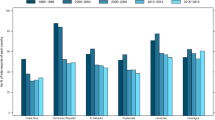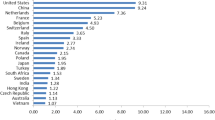Abstract
The expansion of regionalism has spawned an extensive theoretical literature analysing the effects of free trade agreements (FTAs) on trade flows. In this paper we focus on FTAs (also called European agreements) between the European Union (EU-15) and the Central and Eastern European countries (CEEC-4, i.e. Bulgaria, Hungary, Poland and Romania) and model their effects on trade flows by treating the agreement variable as endogenous. Our theoretical framework is the gravity model, and the econometric method used to isolate and eliminate the potential endogeneity bias of the agreement variable is the fixed effect vector decomposition (FEVD) technique. Our estimation results indicate a positive and significant impact of FTAs on trade flows. This finding is robust to the inclusion in the sample of a group of control countries (specifically Belarus, the Russian Federation and the Ukraine) that did not sign an FTA. Besides, we show that trade growth after the FTA agreement with the EU was signed exceeded trade growth of the control group of countries, which did not become members.
Similar content being viewed by others
Notes
Hungary (1991), Poland (1991), Romania (1993), the Czech Republic (1993), Slovakia (1993), Bulgaria (1993), Latvia (1995), Estonia (1995), Lithuania (1995) and Slovenia (1995).
See Baier and Bergstrand (2004).
These models emphasise the role of transport costs in maximising/minimising the welfare of countries (proximity of/distance between partners implies low/high transport costs).
The popularity of the gravity model is highlighted by Eichengreen and Irwin (1995) who consider it “the workhorse for empirical studies of regional integration”.
The programme STATA proposed by the authors executes all three steps and adjusts the variance-covariance matrix. Options like AR (1) error-correction and robust variance-covariance matrix are allowed.
Rose (2004) also compares trade patterns for countries in the GATT/WTO with those outside the system using two dummy variables, one to measure the trade effect if both countries are GATT/WTO and the other if one country is a member and the other is not.
EU-15: Austria, Belgium-Luxemburg, Denmark, the United Kingdom, Finland, France, Germany, Greece, the Netherlands, Ireland, Italy, Portugal, Spain, Sweden.
Bulgaria, Hungary, Poland, Romania.
≈ exp (0.204)−1.
≈ (exp (0.21)−1)− (exp(0.09)−1).
A variance inflation factor value higher than 10 reveals the presence of multicollinearity requiring specific corrections (Gujarati 1995).
References
Aitken, N. D. (1973). The effect of the EEC and EFTA on European trade: A temporal cross-section analysis. American Economic Review, 63(5), 881–892.
Anderson, J. E. (1979). A theoretical foundation for the gravity equation. American Economic Review, 69(1), 106–116.
Baier, S. L., & Bergstrand, J. H. (2004). Economic determinants of free-trade agreements. Journal of International Economics, 64(1), 29–63.
Baier, S. L., & Bergstrand, J. H. (2007). Do free trade agreements actually increase members’ international trade? Journal of International Economics, 71(1), 72–95.
Baldwin, R. E. (1994). Towards an integrated Europe. London: CEPR.
Bergstrand, J. H. (1985). The gravity equation in international trade: Some microeconomic foundations and empirical evidence. Review of Economics and Statistics, 67(3), 474–481.
Bergstrand, J. H. (1989). The generalized gravity equation, monopolistic competition, and the factor-proportions theory in international trade. Review of Economics and Statistics, 71(1), 143–153.
Bhagwati, J., & Panagariya, A. (1996). The theory of preferential trade agreements: Historical evolution and current trends. American Economic Review, 86(2), 82–87.
Carrère, C. (2006). Revisiting the effects of regional trading agreements on trade flows with proper specification of the gravity model. European Economic Review, 50(2), 223–247.
Cooper, C. A., & Massell, B. F. (1965). A new look at customs union theory. Economic Journal, 75(300), 742–747.
De Melo, J., Panagariya, A., & Rodick, D. (1993). The new regionalism: A country perspective. Policy research working paper series 1094. Washington: The World Bank.
Egger, P. (2000). A note on the proper econometric specification of the gravity equation. Economics Letters, 66(1), 25–31.
Egger, P. (2002). An econometric view on the estimation of gravity models and the calculation of trade potentials. The World Economy, 25(2), 297–312.
Egger, P., & Pfaffermayr, M. (2003). The proper panel econometric specification of the gravity equation: A three-way model with bilateral interaction effects. Empirical Economics, 28(3), 571–580.
Egger, P., & Pfaffermayr, M. (2004). Distance, trade and FDI: A SUR Hausman–Taylor approach. Journal of Applied Econometrics, 19(2), 227–246.
Eichengreen, B., & Irwin, D. A. (1995). Trade blocs, currency blocs and the reorientation of world trade in the 1930s. Journal of International Economics, 38(1–2), 1–24.
Fernández, R., & Portes, J. (1998). Returns to regionalism: An analysis of non traditional gains from regional trade agreements. World Bank Economic Review, 12(2), 197–220.
Frankel, J. A. (1997). Regional trading blocs in the world economic system. Washington: Institute for International Economics.
Frankel, J. A., & Wei, S.-J. (1998). Open regionalism in a world of continental trade blocs. IMF Staff Papers, 45(3), 440–453.
Frankel, J. A., Stein, E., & Wei, S.-J. (1996). Regional trading arrangements: Natural or supernatural. American Economic Review, 86(2), 52–56.
Ghosh, S., & Yamarik, S. (2004). Are regional trading arrangements trade creating? An application of extreme bounds analysis. Journal of International Economics, 63(2), 369–395.
Glick, R., & Rose, A. K. (2002). Does a currency union affect trade? The time series evidence. European Economic Review, 46(6), 1125–1151.
Grossman, G. M., & Helpman, E. (1995). The politics of free-trade agreements. American Economic Review, 85(4), 667–690.
Gujarati, D. N. (1995). Basic econometrics (3rd ed.). New York: McGraw-Hill.
Hausman, J. A., & Taylor, W. E. (1981). Panel data and unobservable individual effects. Econometrica, 49(6), 1377–1398.
Helpman, E., & Krugman, P. (1985). Market structure and foreign trade: Increasing returns, imperfect competition, and the international economy. Cambridge: MIT Press.
Hsiao, C. (2003). Analysis of panel data (2nd ed.). Cambridge: Cambridge University Press.
Johnson, H. (1965). An economic theory of protectionism, tariff bargaining and the formation of customs union. Journal of Political Economy, 73(3), 256–283.
Krugman, P. (1991). Geography and trade. Cambridge: MIT Press.
Linnemann, H. (1966). An Econometric Study of International Trade Flows. Amsterdam: North-Holland.
Magee, C. (2003). Endogenous preferential trade agreements: An empirical analysis. Contributions to economic analysis and policy, 2(1), article 15. Berkeley Electronic Press.
Matyas, L. (1997). Proper econometric specification of the gravity model. The World Economy, 20(3), 363–368.
Plümper, T., & Troeger, V. E. (2004). The estimation of time-invariant variables in panel analyses with unit fixed effects. Social Science Research Network, Working Paper.
Pöyhönen, P. (1963). A tentative model for the volume of trade between countries. Weltwirtschaftliches Archiv, 90(1), 93–100.
Rault, C., Sova, A., Sova, R. (2007a). The endogeneity of association agreements and their impact on trade for Eastern countries: Empirical evidence for Romania. Working Paper No. 868. William Davidson Institute, University of Michigan.
Rault, C., Sova, R., Sova, A. (2007b). The role of association agreements within European Union enlargement to Central and Eastern European countries. IZA Discussion Paper No. 2769. Institute for the Study of Labor, Bonn.
Rose, A. K. (2004). Do we really know that the WTO increases trade? American Economic Review, 94(1), 98–114.
Schiff, M., & Winters, L. A. (1998). Regional integration as diplomacy. World Bank Economic Review, 12(2), 271–295.
Soloaga, I., & Winters, L. A. (2001). Regionalism in the nineties: What effect on trade? North American Journal of Economics and Finance, 12(1), 1–29.
Tinbergen, J. (1962). Shaping the world economy: Suggestions for an international economic policy. New York: Twentieth Century Fund.
Viner, J. (1950). The customs union issue. New York: Carnegie Endowment for International Peace.
Wonnacott, P., & Lutz, M. (1989). Is there a case for free trade areas? In J. Schott (Ed.), Free trade areas and US trade policy. Washington: Institute for International Economics.
Wooldridge, J. M. (2002). Econometric analysis of cross section and panel data (2nd ed.). Cambridge: MIT Press.
Acknowledgments
We are very grateful to a referee and a member of the Advisory Board for helpful remarks and suggestions on an earlier draft of this paper.
Author information
Authors and Affiliations
Corresponding author
Additional information
An erratum to this article can be found at http://dx.doi.org/10.1007/s10290-009-0020-7
About this article
Cite this article
Caporale, G.M., Rault, C., Sova, R. et al. On the bilateral trade effects of free trade agreements between the EU-15 and the CEEC-4 countries. Rev World Econ 145, 189–206 (2009). https://doi.org/10.1007/s10290-009-0011-8
Published:
Issue Date:
DOI: https://doi.org/10.1007/s10290-009-0011-8




